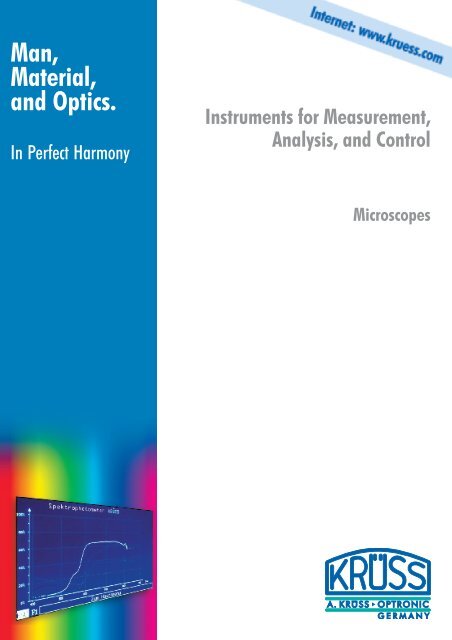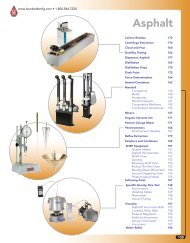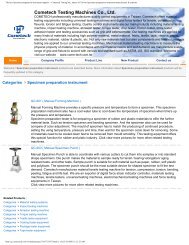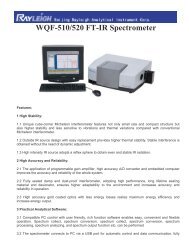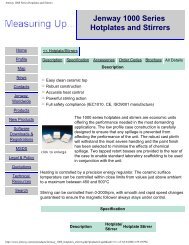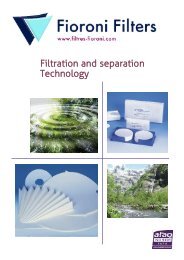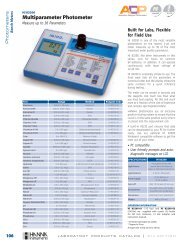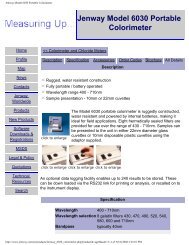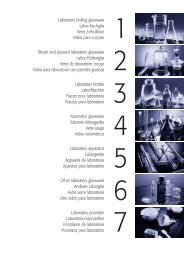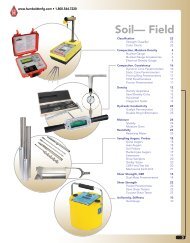Man, Material, and Optics. - Comlibris
Man, Material, and Optics. - Comlibris
Man, Material, and Optics. - Comlibris
Create successful ePaper yourself
Turn your PDF publications into a flip-book with our unique Google optimized e-Paper software.
<strong>Man</strong>,<br />
<strong>Material</strong>,<br />
<strong>and</strong> <strong>Optics</strong>.<br />
In Perfect Harmony<br />
Instruments for Measurement,<br />
Analysis, <strong>and</strong> Control<br />
Microscopes
Lab Microscopes – In a Class of its Own<br />
2<br />
MBL 2000 Binocular Microscope<br />
This robust, universal microscope is designed for general use in laboratories, schools<br />
<strong>and</strong> universities. Its interchangeable head <strong>and</strong> numerous accessories allow it to be<br />
used in many applications. The MBL series can be extended with phase contrast<br />
equipment, dark field condensor, micrometer equipment <strong>and</strong> plane-chromatic<br />
objectives. Features of the MBL series include:<br />
· Inclined binocular optical head<br />
with symmetrical interpupillary distance adjustment (55 - 75 mm)<br />
· Diopter compensation with compensation scale for tube length of 160 mm<br />
· 10x plane eyepieces with a focal length of 25 mm, <strong>and</strong> a field diameter of 18 mm<br />
(15x plane eyepieces are also available)<br />
· Quadruple revolving nosepiece<br />
· Achromatic objectives<br />
Magnification N.A. Working distance<br />
4x 0.10 17.04 mm<br />
10x 0.25 8.05 mm<br />
40x 0.5 0.32 mm (telescopic)<br />
100x 1.25 0.13 mm (oil immersion, telescopic)<br />
· Stable metal st<strong>and</strong>, fitted on both sides with coaxial adjustment<br />
· Coarse <strong>and</strong> fine adjustment knobs (0-200 µm, with subdivisions of 2 µm)<br />
· Coarse adjustment range: 30 mm; fine adjustment range: 30 mm<br />
· Coarse adjustment knob on the right with friction control<br />
ring, <strong>and</strong> on the left with a quick focussing device<br />
· Graduated mechanical XY stage with coaxial adjustment:<br />
- Transverse movement 74 mm<br />
- Longitudinal movement 30 mm (scales with vernier)<br />
- Scale subdivisions 0.1mm<br />
· Built-in low voltage illuminator with:<br />
- Tungsten-halogen bulb 6 V, 20 W,<br />
operates from 100–250 VAC, 50 Hz<br />
- On/off switch, illumination control, removable condensor<br />
· Brightfield ABBE condensor, double lensed:<br />
mounted in centering device (N.A. 1.25), iris diaphragm,<br />
Flip-out filter holder, vertical adjustment<br />
· Glass filters: blue <strong>and</strong> green<br />
MBL 2100 Trinocular Microscope<br />
Data <strong>and</strong> accessories as for the MBL 2000, but with additional<br />
phototube for photographic <strong>and</strong> video camera.<br />
Adapter available.<br />
MML 1500 Monocular Microscope<br />
Similar to MBL 2000, with monocular head inclined at 45 °angle.<br />
MBLKL 2000 Binocular Microscope<br />
The MBLKL is designed for medical examinations, with the same specifications <strong>and</strong><br />
accessories as the MBL 2000, but with a high intensity light source (150 W), light<br />
guide, <strong>and</strong> dark <strong>and</strong> light field condensor. It is well suited for blood testing. Looks<br />
like MBLKL 2100 but without photo tube.<br />
MBLKL 2100 Trinocular Microscope<br />
Data <strong>and</strong> accessories as MBLKL 2000, but with additional phototube.<br />
All models also with five revolving nosepieces: 4x, 10x, 40x, 60x, 100x objectives.<br />
Accessories:<br />
· Plane-achromatic objectives<br />
· Phase-contrast equipment<br />
· Photo <strong>and</strong> video accessories (see page 5)<br />
MBL 2100<br />
MBL 2000<br />
MML 1500<br />
MBLKL 2100
Monocular-Microscopes – Compact <strong>and</strong> Inexpensive<br />
Monocular Microscope Series MML 1200<br />
This basic microscope is ideal for laboratories, schools <strong>and</strong> production areas. All<br />
models have a 45° inclined optical head, 360° turnable, durable metal st<strong>and</strong>, fine<br />
adjustment <strong>and</strong> built-in illumination.<br />
MML 1200 Monocular Microscope<br />
· With wide-field eyepiece 10x<br />
· Triple nosepiece with 4x, 10x <strong>and</strong> 40x achromatic objectives<br />
· Stage with paired clips<br />
· ABBE condensor N.A. 1.25 with iris diaphragm, filter holder <strong>and</strong> filter<br />
· Built-in illumination (110 alt. 230 VAC, 20 W, CE <strong>and</strong> GS approved)<br />
with mirror <strong>and</strong> holder as accessories<br />
MML 1203 Monocular Microscope<br />
Same as MML 1200, but with adjustable built-in illumination.<br />
MML 1204 Monocular Microscope<br />
Same as MML 1200, but with adjustable built-in illumination,<br />
quadruple nosepiece <strong>and</strong> additional 100x oil immersion objective.<br />
MML 1200<br />
Accessories for all models of MML 1200 Series:<br />
· MML 1240: XY movable specimen holder, fixed with one screw to the stage<br />
· Plan eyepiece 15x<br />
· Micrometer eyepiece 10x or 15x, both with 100 divisions<br />
· For further accessories see price list<br />
MML 1240<br />
MML 1204 MML 1203<br />
3
Insight for Specialists<br />
VO PC/TV Video eyepiece<br />
Video eyepiece for PC <strong>and</strong> TV<br />
switchable PAL & NTSC<br />
TP 1001 C<br />
CCD-Color-video camera, 0.45 Lux,<br />
420 TV lines resolution, CCIR-Norm PAL<br />
X300K Reflex Camera<br />
with normal eyepiece<br />
adapter required<br />
Nikon 4500<br />
· Digital camera 4x zoom, 4.0 Mio Pixel<br />
TP-1400 Color Monitor<br />
14“ (36 cm) diagonal in a metal housing.<br />
· Horizontal resolution: 420 lines<br />
· 625 lines, 50 Hz frames interlaced<br />
· Signal input: PAL-CVBS on (75 Ohm)<br />
· Input connector: BNC with switchable impedance<br />
· Power supply: 220 to 240 V, AC, 50 Hz<br />
· Power consumption: 80 W<br />
VO PC/TV<br />
TP 1001 C<br />
TP-1400<br />
X300K<br />
MMB 2200 Metallurgical Inverse Microscope<br />
This inverse microscope is used to identify <strong>and</strong> analyze all kinds of metal including<br />
steels <strong>and</strong> alloys. It is ideal for appraising the quality of castings, examining <strong>and</strong><br />
analyzing raw material as well as metallurgical structures after heat treatment.<br />
Video <strong>and</strong> film photography are possible using accessories.<br />
· Plano eyepieces: 10x <strong>and</strong> 12.5x<br />
· Objectives: 10x, 20x, 40x <strong>and</strong> 100x<br />
· Total magnification: 100x to 1250x<br />
· Filters: green, yellow <strong>and</strong> grey<br />
· Micrometer ocular: 10x, scale division 180<br />
· XY-table, movable: 76 x 50 mm<br />
· Illumination: built-in lamp (6 V, 30 W), brightfield condensor<br />
MMB 2200<br />
4<br />
MBL 3100 Biological Inverse Microscope<br />
The MBL 3100 is multi-purpose microscope used for identifying <strong>and</strong> analyzing<br />
biological substances including laboratory cultures. Accessories include a phototube<br />
<strong>and</strong> adapter for film <strong>and</strong> video photography.<br />
· Plane-achromatic objectives with long working distance<br />
· Plano eyepieces: 10x und 16x<br />
· Magnification: 10x 25x 40x<br />
N.A.: 0.25 0.4 0.6<br />
Working distance: 10.8 4.2 2.8 mm<br />
· Phase contrast: 10x <strong>and</strong> 25x<br />
· Total magnification: 100x to 640x<br />
· Filters: green, blue, yellow <strong>and</strong> grey<br />
· Stage moving range: 76 x 50 mm<br />
· Illumination: built-in lamp (6 V, 20 W)<br />
MBL 3100
Zoom – Infinitely Variable Magnification<br />
MSZ 5200 Stereo Zoom Microscope<br />
Stereo zoom microscope without illumination.<br />
· 10x plano eyepieces, with diopter compensation <strong>and</strong> adjustable interocular<br />
distance<br />
· Zoom lense from 0.7x to 4.0x, for zoom magnification from 7x to 40x<br />
(extended up to 160x)<br />
· Metal st<strong>and</strong> with working distance 70 mm<br />
Accessories: · Eyepieces 20x 14x - 80x magnification<br />
· Additional lens 0.5x 3.5x - 20x magnification<br />
· Additional lens 2x 14x - 80x mag., with 20x eyepieces -160x<br />
MSZ 5300<br />
MSZ 5300 Stereo Zoom Microscope<br />
Like MSZ 5200, but with an additional photo tube for video or film camera<br />
adaption.<br />
MSZ 5400 Stereo Zoom Microscope<br />
Stereo zoom microscope with built-in illumination.<br />
· 10x plano eyepieces, with diopter compensation <strong>and</strong> adjustable interocular<br />
distance<br />
· Zoom lenses from 0.7x to 4.5x,<br />
for zoom magnification from 7x to 45x (extendable up to 180x)<br />
· Metal st<strong>and</strong> with 90 mm working distance<br />
· Built-in illumination for direct <strong>and</strong> transmitted light (6 V, 15 W)<br />
Accessories: · Eyepieces 20x 14x - 90x magnification<br />
· Additional lens 0.5x 3.5x - 22.5x magnification<br />
· Additional lens 2x 14x - 90x mag., with 20x eyepieces -180x<br />
MSZ 5600 Stereo Zoom Microscope<br />
Same as MSZ 5400, but supplied with additional photo tube for video or film<br />
camera adaption.<br />
MSZS 5200/MSZS5300<br />
Like MSZ 5200/5300 but with swiveling st<strong>and</strong><br />
MSZSL 5200/MSZSL 5300<br />
Like MSZ 5200/5300 but with swiveling st<strong>and</strong>, halogen lamp <strong>and</strong> power supply<br />
MSZ 5400 MSZ 5600<br />
MSZS 5200<br />
5
Stereo Microscopes for Work <strong>and</strong> Leisure Time<br />
Stereo Microscope Series MSL 4000<br />
Low-cost, different magnifications <strong>and</strong> applications are possible using the wide<br />
selection of accessories. With direct view or 45° inclined optical head <strong>and</strong><br />
adjustable interocular distance. All models are supplied with a durable metal st<strong>and</strong><br />
<strong>and</strong> built-in illumination (110 alt. 230 VAC, 10 W).<br />
MSL 4330 Stereo Microscope<br />
· With built-in incident <strong>and</strong> transmitted illumination (10 W)<br />
· 45° view<br />
· Switchable nosepiece 1x <strong>and</strong> 3x<br />
· Eyepiece 10x, magnification 10x <strong>and</strong> 30x<br />
MSLS 4330<br />
Like MSZ 4330 but with swiveling st<strong>and</strong><br />
MSLSL 4330<br />
Like MSZ 4330 but with swiveling st<strong>and</strong>, halogen lamp <strong>and</strong> power supply<br />
MSL 4320 Stereo Microscope<br />
· With built-in incident <strong>and</strong> transmitted illumination (10 W)<br />
· 45° view<br />
· Switchable nosepiece 2x <strong>and</strong> 4x<br />
· Eyepiece 10x, magnification 20x <strong>and</strong> 40x<br />
MSL 4020/4040 Stereo Microscope<br />
· 45° view<br />
· without illumination<br />
· sliding objective 2x or 4x<br />
· eyepieces 10x, magnification 20x or 40x<br />
Other easy-to-use microscopes on request.<br />
Accessories:<br />
· Eyepieces 20x<br />
· For other accessories see price list<br />
MSL 4330<br />
MSLS 4330<br />
MSL 4020<br />
New: LDR 10<br />
Daylight LED Ringlamp for all microscopes<br />
Fiber Optic Light Source<br />
For use with all microscopes. Delivery without fibre optic light guide.<br />
KL 5110 Fiber Optic Light source without light guide, not intensity controlled<br />
(110–250 VAC)<br />
KL 5120 Fiber Optic Light Source<br />
· Long life halogen lamp (8 V, 20 W, 100–250 VAC)<br />
· Iris-operated intensity control without colour change<br />
· Built-in adapter for spectroscope wavelength scale illumination<br />
KL 5120<br />
6<br />
KL 5125 Fiber Optic Light Source<br />
· Halogen lamp (15 V, 150 W, 110 alt. 230 VAC)<br />
· Light intensity control<br />
Fiber Optic Light Guide<br />
These accessories for cold light sources allow the light to be directed exactly where it is<br />
needed.<br />
KL 5130<br />
KL 5131<br />
KL 5133<br />
KL 5136<br />
KL 5134<br />
KL 5135<br />
KL 5155<br />
Flexible fiber optic light guide, 1-arm-type, 500 mm long<br />
Flexible fiber optic light guide, 2-arm type, 500 mm long<br />
Flexible fiber optic light guide attachment,<br />
290 mm long, nozzle 90° bent<br />
Fixed fiber optic light guide attachment, nozzle 90° bent<br />
Condensing lens with adapter for more light intensity<br />
Diffuser lens with opaque glass for incident light<br />
Polarizing filter<br />
KL 5130 - 5155<br />
LDR 10
Under the Microscope:<br />
The History of a Hamburg Family<br />
More than 200 years – a long time for a company’s history.<br />
The family enterprise of A. Krüss spent these last two centuries<br />
keeping up with the breathtaking developments in<br />
science, technology, optics <strong>and</strong> precision engineering. An<br />
amazing number of high-precision optical <strong>and</strong> other quite<br />
different products have been shipped world-wide from the<br />
Hamburg laboratories. Although<br />
some have long since been forgotten,<br />
more recent products, are known<br />
throughout the world.<br />
But let us return to the origins, to<br />
1796 <strong>and</strong> the Hamburg workshop of<br />
Edmund Gabory, “Mechanicus<br />
Opticus“. Gabory was trained in<br />
London by none other than Jesse<br />
Ramsden, the world famous optician,<br />
at a time when precision engineering<br />
was flourishing. On finishing his<br />
training in 1790, Edmund set up a<br />
workshop of his own in London<br />
Holborn. In 1796 he moved with his<br />
family to Hamburg, the international<br />
port city <strong>and</strong> trading centre. This is<br />
where the talented optical engineer<br />
established his career <strong>and</strong> saw his<br />
business prosper. When Gabory died in 1813, the company<br />
was taken over by his widow Mary <strong>and</strong> their son Edmund<br />
Nicolas. In 1823 Gabory’s daughter Mary Ann married<br />
Andres Krüss.<br />
The combination of scientific skill with Hanseatic business<br />
acumen, tradition <strong>and</strong> perspective proved to be a successful<br />
formula. Together with his wife <strong>and</strong> her brother, Andres<br />
Krüss led the company to further success, adding nautical<br />
instruments <strong>and</strong> charts to their product range. Brisk trade<br />
with the neighboring Sc<strong>and</strong>inavian <strong>and</strong> other foreign<br />
countries developed. In 1844 Andres Krüss established a<br />
company of his own named Optical Institute A. Krüss. Four<br />
years later he fell victim to one of the cholera epidemics.<br />
After his death, the company was first run by his widow,<br />
who then h<strong>and</strong>ed it over to her sons Edmund <strong>and</strong> William<br />
in 1851.<br />
In 1859 Edmund set up the company’s own lens-grinding<br />
facility. In addition to camera lenses, they later manufactured<br />
special magic lanterns equipped with two objectives<br />
for “dissolving views“: A mechanism made the projection<br />
of the first slide disappear while the second image appeared.<br />
In order to demonstrate the quality of his photographic<br />
lenses he opened his own photographic studio. He<br />
was awarded first prize for his lenses at the World Exhibi-<br />
Andres Krüss,<br />
Founder of the optical institute A. Krüss<br />
tion in London in 1862. In 1865 Krüss patented his famous<br />
“Magic Lantern“, forerunner of the cinema projector.<br />
Still in existence at this time, the original company of<br />
Edmund Gabory was merged with Optical Institute A. Krüss<br />
in 1886. Edmund‘s son Hugo returned to take over the<br />
management of the company in 1888 after completing his<br />
training with distinction at the optical<br />
factory of Steinheil <strong>and</strong> his university<br />
studies in Munich. In a period of many<br />
new inventions <strong>and</strong> scientific developments,<br />
Dr. Hugo Krüss established<br />
himself as a pioneer in theoretical <strong>and</strong><br />
applied photometry. His <strong>Man</strong>ual of<br />
Electromechanical Photometry became<br />
a st<strong>and</strong>ard work. In his capacity<br />
as Chairman of the German Society<br />
for Precision Engineering <strong>and</strong> <strong>Optics</strong>,<br />
Dr. Krüss was appointed by the<br />
German government as an expert for<br />
customs <strong>and</strong> excise in 1892; while in<br />
office, he convinced the government<br />
to establish a tariff heading specifically<br />
for “scientific instruments“. In<br />
1917 the Hamburg Senate awarded<br />
Dr. Krüss a professorship in recognition<br />
of his achievements in the scientific world <strong>and</strong> his<br />
engagement in public affairs.<br />
In 1904 Hugo’s son, Dr. Paul Krüss joined the family company<br />
at the age of only 24. The so-called “master craftsman<br />
with a doctorate“ managed the company from 1920,<br />
through the troubled times of crisis <strong>and</strong> World War, as well<br />
as during the later restructuring of the German economy.<br />
Using his international connections in the world of science,<br />
he developed a range of scientific instruments including<br />
laboratory equipment for schools.<br />
Andres Krüss, Paul’s son, was an engineer <strong>and</strong> became a<br />
partner in 1946 in the 5 th generation. Due to his hard<br />
work during the “German Economic Miracle“, Andres secured<br />
new customers <strong>and</strong> new markets. Dr. Paul Krüss died<br />
in 1976 at the age of 96. No one else had ever run the<br />
company so long.<br />
Today the company is run in the 6 th generation by Martina<br />
Krüss-Leibrock, who took over A. Krüss in 1980. Martina is<br />
the daughter of Andres who died in 1992. And today the<br />
company A. Krüss remains famous for high-precision, stateof-<br />
the-art measuring instruments. Thus the traditional<br />
craftsman’s art of precision engineering has been perfectly<br />
combined with innovative electronic technology.<br />
7


